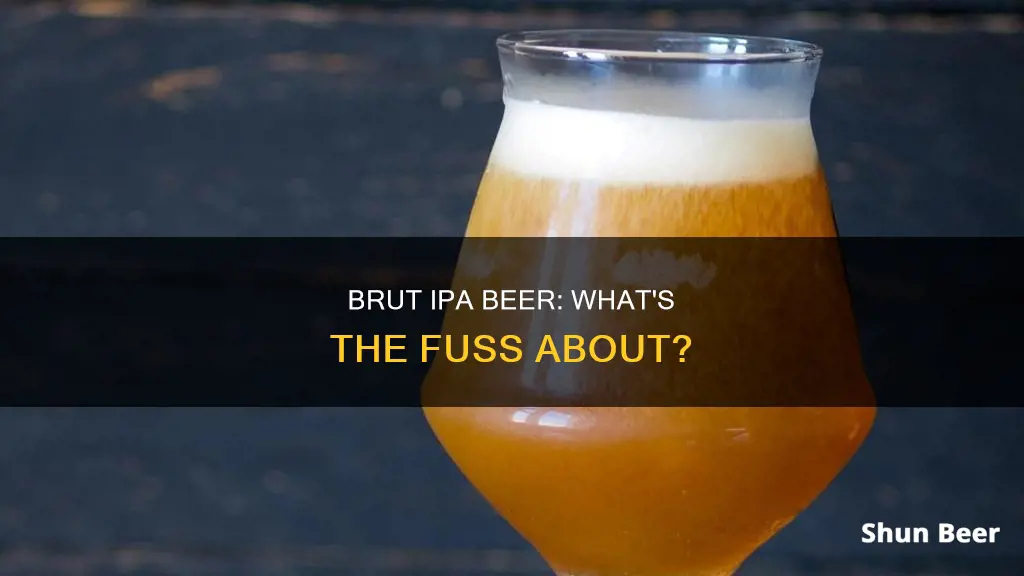
Brut IPA is a style of beer that was first brewed in San Francisco in 2017. It is a very dry, highly effervescent variant of American IPA, with a light golden colour and a Champagne-like quality. The dryness is achieved by using an enzyme, amyloglucosidase, which breaks down complex sugars, resulting in a beer with minimal bitterness and a light colour. Brut IPAs are usually highly hopped with aromatic hops, and have a fruity-hoppy, crisp and clean finish.
What You'll Learn

The creation of Brut IPAs
The Brut IPA is a new style of India Pale Ale (IPA) that was first created in late 2017 by Kim Sturdavant, the brewmaster of Social Kitchen and Brewery in San Francisco, California. Sturdavant had the idea to use the enzyme amyloglucosidase (AMG) to remove the sugars in an IPA, creating a beer that was lighter in colour, drier, and with no residual sugars—essentially combining the bone-dry aspect of Champagne with an IPA.
AMG is an enzyme that has been used in brewing for a while, particularly in light beers and to balance big beers like imperial stouts. It breaks down complex sugars that might not otherwise ferment, allowing the yeast to consume more of the sugars during fermentation and bulk up their alcohol content. Sturdavant had been using AMG on his triple IPA for a few years to prevent it from becoming overly sweet, and he wondered what effect it would have on a standard-strength IPA.
When his schedule allowed in November 2017, Sturdavant brewed a traditional IPA and added the AMG after the first round of fermentation. The result was a bone-dry, super-aromatic, slightly hazy, bright IPA. He initially called it "Hop Champagne Extra Brut IPA", taking inspiration from the world of Champagne where "brut" indicates dryness. The style eventually became known simply as Brut IPA.
The Brut IPA style is characterised by its extreme dryness, effervescence, light colour, and low bitterness. It is highly hopped with aromatic hops, but the focus is on achieving a pronounced hop flavour and aroma rather than bitterness. Fruit-forward flavours and aromas are achieved through late hopping, dry hopping, and the use of neutral ale yeast strains. The addition of an amylase enzyme further reduces the final gravity.
Since its creation, the Brut IPA style has spread like wildfire, with brewers near and far adding it to their lineups and experimenting with different ingredients and techniques to perfect the style. While the style is still in its infancy and continues to evolve, it has already sparked excitement in the craft brewing community and among drinkers.
The pH Mystery: IPA Beer's Unique Composition
You may want to see also

The dryness of Brut IPAs
This extreme dryness is achieved through the use of an amylase enzyme, specifically amyloglucosidase, which breaks down complex sugars that may not otherwise ferment. This enzyme allows the yeast to fully break down any residual sugars left during the brewing process, resulting in a drier beer. The use of this enzyme is crucial to achieving the signature dryness of Brut IPAs.
However, the dryness of Brut IPAs can also be a double-edged sword. While some appreciate the crisp, dry finish, others may find that it accentuates any off-flavours in the beer. The dryness can make it difficult for mediocre breweries to cover up any flaws in their beer, as the sugar and hops typically used to mask these flavours are less effective in a drier beer. This may be one reason why Brut IPAs have not achieved mainstream popularity and remain a niche style enjoyed by those who appreciate their unique characteristics.
Sodium in IPA Beer: What's the Deal?
You may want to see also

Brut IPA ingredients
The Brut IPA is a very dry, highly carbonated, and effervescent variant of the American IPA. It is characterised by a light body, a strong hop flavour, and low bitterness. The key ingredient in a Brut IPA is an enzyme that breaks down complex starches into simpler sugars that can be more easily metabolised by yeast. The most commonly used enzyme is glucoamylase, also known as amyloglucosidase. This enzyme is typically added during the mash or in the wort when pitching the yeast.
The base malt for a Brut IPA is usually Pilsner malt, which gives the beer its distinct light colour. Some brewers also add a dose of simple sugar, such as table sugar or corn syrup, to increase the dryness. Adjuncts such as flaked rice, corn, and flaked oats can also be used to add subtle but important notes to the beer.
When it comes to hops, modern, tropical hops are often favoured in Brut IPAs. Popular varieties include El Dorado, Mosaic, Citra, Galaxy, Mandarina Bavaria, Hüll Melon, and Nelson Sauvin. These hops impart fruity and floral aromas and flavours, such as citrus, cherry, mango, and stone fruit. The hops are typically added during the whirlpool or dry-hopping stages, with larger amounts of dry hops added to enhance the aroma.
In addition to the ingredients mentioned above, a high-quality yeast nutrient is essential to give the yeast more than just glucose to feed on. Brewers also recommend adding a small amount of dried malt extract (DME) to improve head retention. Overall, the key to crafting a successful Brut IPA is finding the right balance between dryness, carbonation, and hop character.
The Sweetness of IPAs: Fruit or Fiction?
You may want to see also

How to brew a Brut IPA
The Brut IPA is a dry, emerging style of IPA that has recently been created. The key to this style is the use of the enzyme amyloglucosidase, which breaks down complex sugars to create a bone-dry finish. The style is also characterised by minimal bitterness and malt character, allowing the hoppiness to shine through.
To brew a Brut IPA, you'll need to follow a few key steps and consider some specific ingredients. Here's a guide on how to brew your own Brut IPA:
Ingredients and Amounts
For a 5-gallon (19-liter) batch, you will need:
- 8 lb Pilsner malt
- 1 lb flaked corn
- 1 lb flaked rice
- .17 oz Mosaic [12.25% AA] hops
- 2.5 oz Mosaic [12.25% AA] hops
- 7.5 oz Mosaic [12.25% AA] hops
- Neutral Ale yeast
- 0.65 ml Amyloglucosidase
Mashing
Add your grains (Pilsner malt, flaked corn, and flaked rice) to your mash tun with enough water to cover them. Aim for a mash temperature of 143-146 degrees Fahrenheit to avoid denaturing the amyloglucosidase enzyme. Stir the mixture well and let it rest for about an hour to allow the enzyme to break down the complex sugars.
Boiling
After mashing, transfer the wort to a boil kettle and boil for 60 minutes. During the boil, you will add your hops at different intervals. Add .17 oz of Mosaic hops at the 15-minute mark, and 2.5 oz of Mosaic hops at the whirlpool or flameout stage.
Fermentation
Cool the wort and transfer it to a fermenter. Pitch your neutral ale yeast and ferment until the specific gravity reaches terminal gravity. This style typically has an original gravity (OG) of around 1.054 and an ABV of about 7%.
Dry Hopping
Once the terminal gravity is reached, add 7.5 oz of Mosaic hops for dry hopping. Let the beer sit for a couple of days to absorb the hop aromas and flavours.
Bottling or Kegging
Finally, package your Brut IPA to a higher level of carbonation, aiming for around 2.7-3 volumes of CO2. This will help mimic the qualities of a sparkling wine, which is part of the style's unique character.
Remember, this is just a basic guide, and you can experiment with different hop varieties, yeast strains, and grain bills to create your own unique take on the Brut IPA style.
Sour Beer vs. IPA: What's the Difference?
You may want to see also

The popularity of Brut IPAs
Brut IPAs are a new style of India Pale Ale (IPA) that has taken the craft-brewing community by storm. Created by Kim Sturdavant, the brewmaster at Social Kitchen and Brewery in San Francisco, this style of beer combines the bone-dry aspect of Champagne with the hoppiness of an IPA. The result is a beer that is very pale, dry, and effervescent, with minimal bitterness and a fruity-hoppy, crisp, and clean finish.
The key to achieving the super-dry character of Brut IPAs is the use of enzymes, specifically amyloglucosidases. This enzyme breaks down complex sugars that might not otherwise ferment, allowing the yeast to consume more of the sugars during fermentation and resulting in a drier beer. The use of adjuncts such as rice and corn also helps to lighten the color and provide subtle additional flavors, such as a coconut flavor from the rice and a creamier mouthfeel from the corn.
The Brut IPA style has caught on like wildfire, with brewers across the United States and even in Poland experimenting with their own versions. Within just days of Sturdavant's creation, the city's beer scene was buzzing, and brewers near and far were adding it to their lineups. The style is still in its infancy, with brewers experimenting with different ingredients and techniques to perfect their Brut IPAs. Despite the variations in flavor, color, and texture, most Brut IPAs are crisp, light, and somewhat citric, with a bubbly, golden appearance that would not be out of place for a toast at a special occasion.
As the Brut IPA style continues to evolve, it will be interesting to see how it is interpreted by different brewers and whether it will become a lasting favorite or a short-lived fad.
How Does Guinness Beer Float on Other Beers?
You may want to see also
Frequently asked questions
A Brut IPA is a style of beer that combines the bone-dry aspect of a Champagne with an India Pale Ale. It is a very pale, very dry, highly effervescent variant of an American IPA, with a low bitterness level.
Most Brut IPAs are crisp, light, and somewhat citric. They are highly hopped with aromatic hops, which gives them a fruity-hoppy, crisp and clean finish.
To achieve the super dry character of a Brut IPA, an extra brewing ingredient is added to the classical ones: enzymes (specifically amyloglucosidases). The AMG enzyme helps to break down long chains of sugars derived from malt, which helps the yeast to consume more of the sugars during fermentation.







